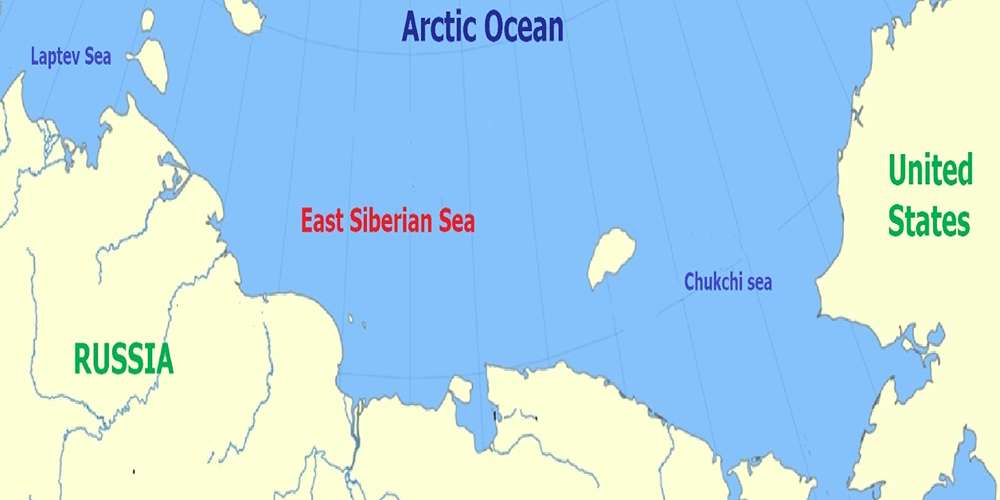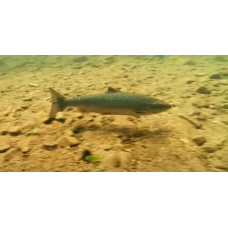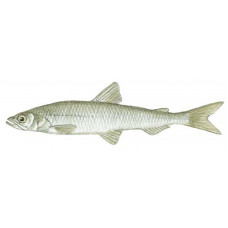Fauna of the East Siberian Sea
 A marginal sea of the Arctic Ocean off the northeastern coast of Asia, between the Novosibirsk Islands and Wrangel Island. It is bordered by the Laptev Sea to the west and the Chukchi Sea to the east. The northern boundary runs along the edge of the mainland shelf, approximately at the isobath of 200 m (79°N). Its area is 913 thousand km2, volume 49 thousand km3. The maximum depth is 915 meters. The climate of the sea is arctic. In winter, cold southwest and south winds blow over the sea. Average air temperatures in February are from -28 to -30 °C (minimum -50 °C). In July in the southern part from 3 to 7 °C, in the northern part from 0 to 2 °C. In summer, the weather over the sea is mostly cloudy with fine drizzle, sometimes wet snow, and prevailing winds from the north. In autumn, the speed of the northwest and northeast winds increases to 20-25 m/s on the coast, and at a distance from the coast the strength of the storm winds reaches 40-45 m/s. The annual rainfall is 100-200 mm. The sea is completely covered with ice from October to July. The salinity of the sea surface increases from the southwest to the northeast. In winter it is 4-5‰ in the south, increases to 28-30‰ in the central areas of the sea and to 31-32‰ in the north of the sea. In summer, salinity decreases to 13-22‰ in the coastal zone, 24-26‰ in the north near the ice edge as a result of river water inflow and ice melting. Salinity increases with depth.
A marginal sea of the Arctic Ocean off the northeastern coast of Asia, between the Novosibirsk Islands and Wrangel Island. It is bordered by the Laptev Sea to the west and the Chukchi Sea to the east. The northern boundary runs along the edge of the mainland shelf, approximately at the isobath of 200 m (79°N). Its area is 913 thousand km2, volume 49 thousand km3. The maximum depth is 915 meters. The climate of the sea is arctic. In winter, cold southwest and south winds blow over the sea. Average air temperatures in February are from -28 to -30 °C (minimum -50 °C). In July in the southern part from 3 to 7 °C, in the northern part from 0 to 2 °C. In summer, the weather over the sea is mostly cloudy with fine drizzle, sometimes wet snow, and prevailing winds from the north. In autumn, the speed of the northwest and northeast winds increases to 20-25 m/s on the coast, and at a distance from the coast the strength of the storm winds reaches 40-45 m/s. The annual rainfall is 100-200 mm. The sea is completely covered with ice from October to July. The salinity of the sea surface increases from the southwest to the northeast. In winter it is 4-5‰ in the south, increases to 28-30‰ in the central areas of the sea and to 31-32‰ in the north of the sea. In summer, salinity decreases to 13-22‰ in the coastal zone, 24-26‰ in the north near the ice edge as a result of river water inflow and ice melting. Salinity increases with depth.
Inhabitants of the East Siberian Sea
The flora and fauna of these places are poor due to the harsh ice conditions. Nevertheless, the sea offers a variety of flora and fauna that have adapted to life in this unique ecosystem. Its waters are home to a variety of marine animals, including mammals, sea turtles, fish and crustaceans. Phytoplankton blooms are short-lived in the summer, brown, blue-green, diatom and red algae can be found in the coastal zone of the western part, and zooplankton is dominated by Pacific Copepod species. Occasionally some species of coelenterata, echinoderm and bivalvia can be found. Pteropods and tunicates appear from time to time. Bottom life is much rarer than in neighboring seas, Polychaete, Amphipoda and Isopoda have settled in the local bottom. On Wrangel and Herald Islands there is an Arctic reserve, which is the main breeding ground for polar bears and walruses.
Fish in the East Siberian Sea
Fishing in this sea is not particularly developed and has only local importance, as there are few commercial fish species in the sea and only the strongest survive. The main species are: polar smelt (Osmerus eperlanus), saffron cod (Eleginus gracilis), Arctic cod (Arctogadus glacialis), navaga (Eleginus nawaga), Arctic flounder (Liopsetta glacialis). In the coastal zone, near the mouths of flowing rivers, one can find valuable fish species of the Salmonidae family: Arctic char (Salvelinus alpinus) and muksun (Coregonus muksun). They come here from the rivers and do not migrate far north. Large schools of nelma (Stenodus nelma), arctic cisco (Coregonus autumnalis) and broad whitefish (Coregonus nasus) are common. There is no information about sharks living in the waters of this sea. But it is possible that there is a Greenland shark (Somniosus microcephalus), which almost never appears on the surface of the sea, preferring to stay in the middle layers of water.
Mammals of the East Siberian Sea
Ringed seal (Phoca hispida), bearded seal (Erignathus barbatus) and walrus (Odobenus rosmarus) inhabit the coasts and ice fields of this sea, lazily bobbing on the shores. Bowhead whale (Balaena mysticetus), gray whale (Eschrichtius robustus), beluga whale (Delphinapterus leucas) and narwhal (Monodon monoceros) frequent the waters. As in all northern coastal seas, walruses are harvested only for the needs of the local population, as they are protected.
Salmonidae
Salmonidae is a family of fishes of the order Salmoniformes. Passable and freshwater fishes. They li..
Smelt
Latin name Osmerus eperlanus Other names European Smelt Identification Like salmon and trout, t..


